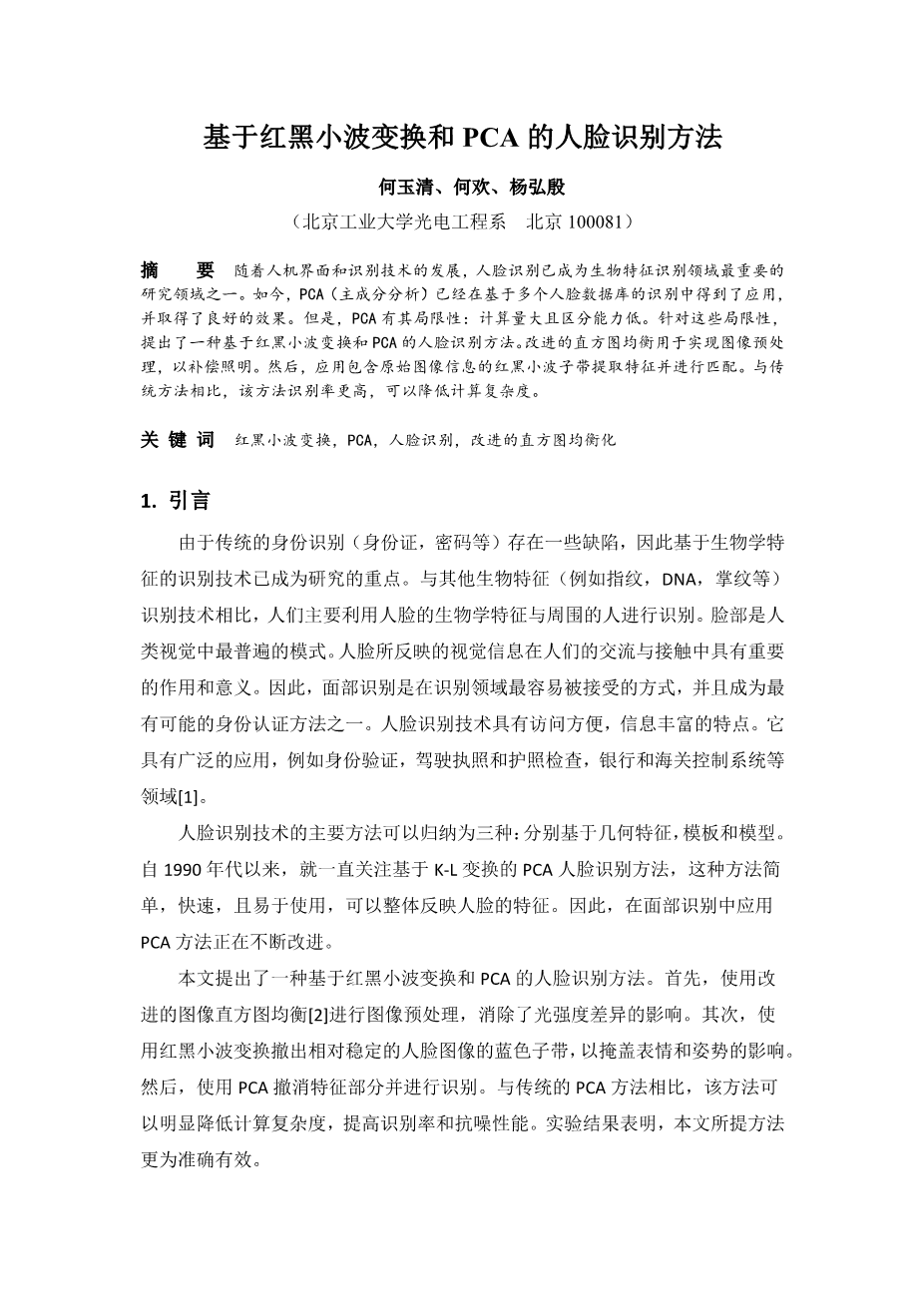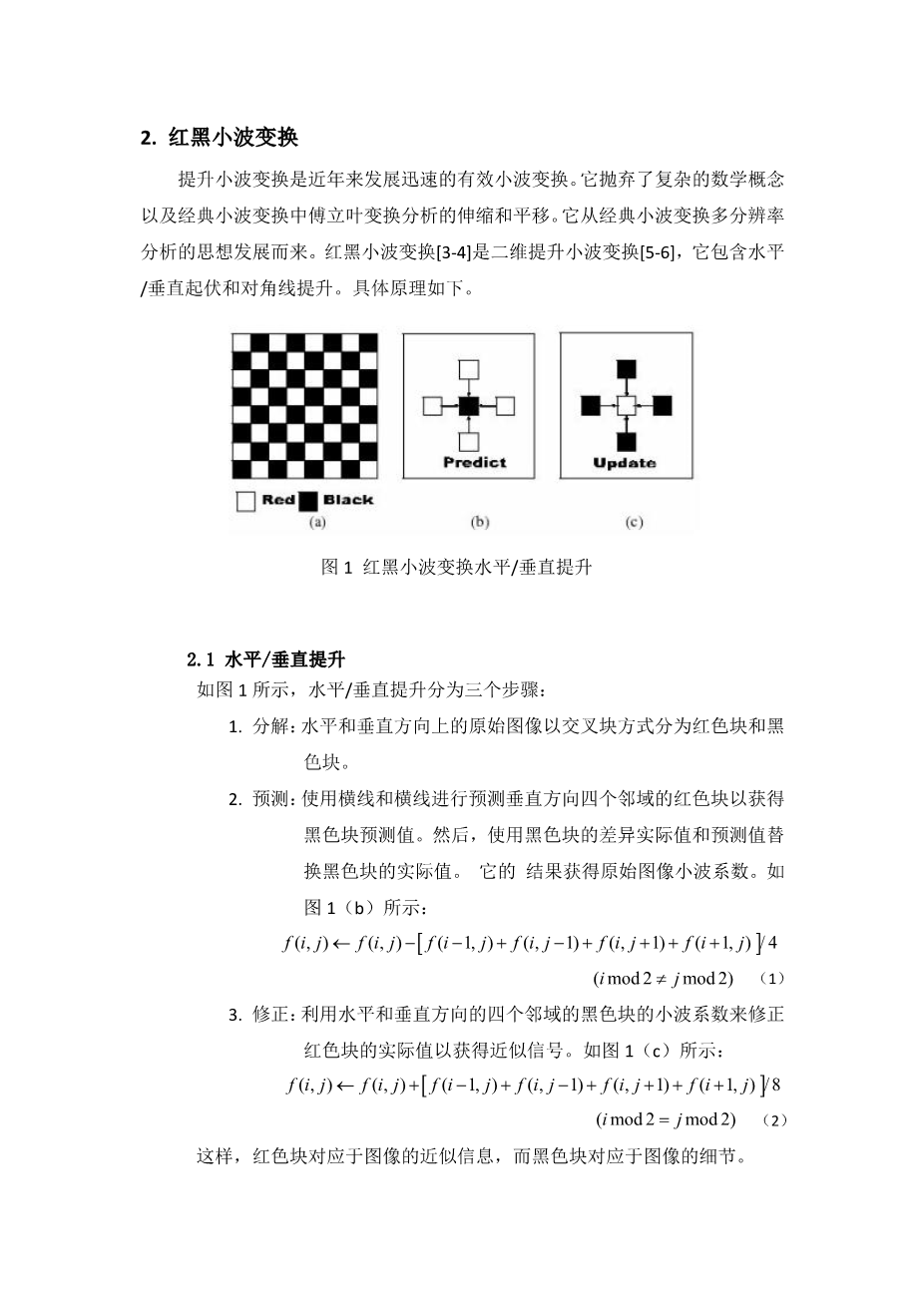Method of Face Recognition Based on Red-Black
Wavelet Transform and PCA
Yuqing He, Huan He, and Hongying Yang
Department of Opto-Electronic Engineering,
Beijing Institute of Technology, Beijing, P.R. China, 100081 20701170@bit.edu.cn
Abstract. With the development of the man-machine interface and the recogni-tion technology, face recognition has became one of the most important research aspects in the biological features recognition domain. Nowadays, PCA(Principal Components Analysis) has applied in recognition based on many face database and achieved good results. However, PCA has its limitations: the large volume of computing and the low distinction ability. In view of these limitations, this paper puts forward a face recognition method based on red-black wavelet transform and PCA. The improved histogram equalization is used to realize image pre-processing in order to compensate the illumination. Then, appling the red-black wavelet sub-band which contains the information of the original image to extract the feature and do matching. Comparing with the traditional methods, this one has better recognition rate and can reduce the computational complexity.
Keywords: Red-black wavelet transform, PCA, Face recognition, Improved histogram equalization.
- Introduction
Because the traditional status recognition (ID card, password, etc) has some defects, the recognition technology based on biological features has become the focus of the re-search. Compared with the other biological features (such as fingerprints, DNA, palm prints, etc) recognition technology, people identify with the people around mostly using the biological characteristics of human face. Face is the most universal mode in human vision. The visual information reflected by human face in the exchange and contact of people has an important role and significance. Therefore, face recognition is the easiest way to be accepted in the identification field and becomes one of most potential iden-tification authentication methods. Face recognition technology has the characteristics of convenient access, rich information. It has wide range of applications such as iden-tification, drivers license and passport check, banking and customs control system, and other fields[1].
The main methods of face recognition technology can be summed up to three kinds: based on geometric features, template and model separately. The PCA face recognition method based on K-L transform has been concerned since the 1990s. It is simple, fast. and easy to use. It can reflect the person faces characteristic on the whole. Therefore, applying PCA method in the face recognition is unceasingly improving.
D.-S. Huang et al. (Eds.): ICIC 2008, LNCS 5226, pp. 561–568, 2008. copy; Springer-Verlag Berlin Heidelberg 2008
This paper puts forward a method of face recognition based on Red-Black wavelet transform and PCA. Firstly, using the improved image histogram equalization[2] to do image preprocessing, eliminating the impact of the differences in light intensity. Sec-ondly, using the Red-Black wavelet transform to withdraw the blue sub-band of the relative stable face image to obscure the impacts of expressions and postures. Then, using PCA to withdraw the feature component and do recognition. Comparing with the traditional PCA methods, this one can obviously reduce computational complexity and increase the recognition rate and anti-noise performance. The experimental results show that this method mentioned in this paper is more accurate and effective.
- Red-Black Wavelet Transform
Lifting wavelet transform is an effective wavelet transform which developed rapidly these years. It discards the complex mathematical concepts and the telescopic and translation of the Fourier transform analysis in the classical wavelet transform. It de-velops from the thought of the classical wavelet transform multi-resolution analysis. Red-black wavelet transform[3-4] is a two-dimensional lifting wavelet transform[5-6], it contains horizontal/vertical lifing and diagonal lifting. The specific principles are as bellow.
-
- Horizontal /Vertical Lifting
As Fig.1 shows, horizontal /vertical lifting is divided into three steps:
1. Decomposition: The original image by horizontal and vertical direction is divided into red and black block in a cross-block way.
2. Prediction: Carry on the prediction using horizontal and the
vertical direction four neighborhoods red
blocks to obtain a black block predicted value.
Then, using the difference of the black block
actual value and the predicted value to
substitute the black block actual value. Its
result obtains the original image wavelet
coefficient. As Fig.1(b) shows:
(1)
3. Revision:
Using the horizontal and vertical direction four neighborhoods black blocks wavelet coefficient to revise the red block actual value to obtain the approximate signal. As Fig.1(c) shows:
(2)
In this way, the red block corresponds to the approximating information of the image, and the black block corresponds to the details of the image.
-
- Diagonal Lifting
On the basis of horizontal /vertical lifting, we do the diagonal lifting. As Fig.2 shows, it is also divided into three steps:
Fig.2.Diagonal lifting
1.Decomposition: After horizontal /vertical lifting, dividing the obtained red blo
剩余内容已隐藏,支付完成后下载完整资料


英语译文共 8 页,剩余内容已隐藏,支付完成后下载完整资料
资料编号:[246363],资料为PDF文档或Word文档,PDF文档可免费转换为Word
以上是毕业论文外文翻译,课题毕业论文、任务书、文献综述、开题报告、程序设计、图纸设计等资料可联系客服协助查找。


